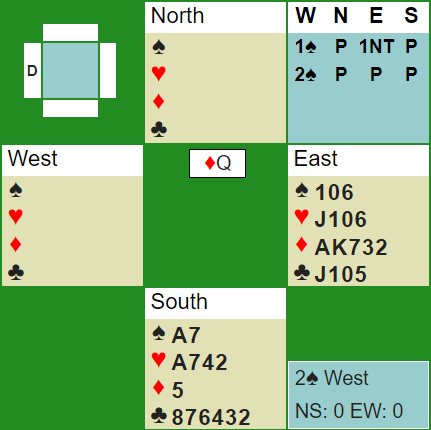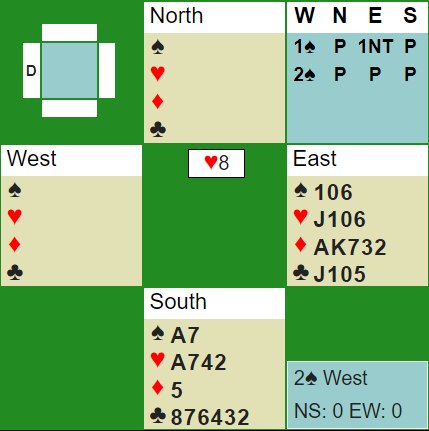AuthorIt is very easy to see intermediate or even advanced players getting confused about the proper signalling method when you are breaking a new suit in defense. One of the most important principles of effective bridge defense is that the meaning of your signals is very much context-based. Thus, it is not possible to define absolute rules that will function in all hands. Even so, it is possible to approach the subject statistically, which will give us a few rules of thumb. Regardless of your partnership's agreements when it comes to the priority of signals in the opening lead (attitude, count, or something else), there is little controversy that when you are breaking a new suit in the mid-game, you should -- if you are interested in signalling at all! -- prioritize an attitude signal. The reason for this consensus is that the defensive players quite often have a good idea of their combined strength (once dummy comes down), taking into account clues from the bidding, and the main areas of ignorance are the location of honors. Attitude signals help your partner project the combined assets with more precision, In this context, a small card indicates interest in this suit being returned, and a high card indicates interest in a switch. Note the careful wording I used. Most often "interest in this suit being returned" means an honor, and "interest in a switch" means a topless suit (and honors elsewhere), but there are exceptions, and it is important that both players are aware that an attitude signal is not a mindless description of your holding in your suit, but rather a suggestion about the defense of the entire hand. A recent example, modified to make the point clearer: Declarer wins the lead and plays a trump. You win the spade trick with the Ace and cannot trust absolutely any spade spot from partner as an indication of a side entry (he may have something like KJx). You want to get to partner's hand to score a diamond ruff. Let us ignore the more advanced discussion of what suit you should decide to lead now (do you realize that declarer is probably short in clubs? do you see why?) and simply state that you will lead a heart. You should clearly lead a high heart, because you want partner to switch rather than keep on playing hearts. In this case, the switch is a 2nd round of diamonds, which will allow you to ruff. Note that you are signalling with the entire hand in mind, not merely your holding in hearts. Now, let us suppose that your hand is A Axxxx xx xxxxx. Now, if you decide to play a heart, you have no pressing desire for a switch. On the contrary, it is quite likely that the best defense is for partner to win this heart trick (if possible) and continue hearts, and so you should lead a small heart, to indicate a desire to see this suit continued. In some situations, you may be able to give two pieces of information with the same card, but they are quite rare. I am a believer in clear (as clear as possible -- very clear indeed!) signals, and so, in both of these positions, there are only two choices for me: the top heart and the low heart. Trying to show both an honor and, say, 4 or 5 hearts is a pipe dream. It is better for you to give your clear signal and for partner to know that you are showing attitude rather than count, in this position. (There will be positions in which count will be of paramount importance. I may deal with them in a later article). All that was said is valid when we talk about the first trick in the suit that is being handled. But what if we are talking about the 2nd trick in the suit? Let us repeat that diagram, with one small change: Your partner led a 3rd highest Eight of hearts. He has therefore H98(x). (It is unlikely that he is short in hearts since declarer would have 4 cards there, and probably would have mentioned the suit). You don't know which honor he has. It is either the King or the Queen.
You win the heart Ace and (let us say) play your singleton diamond. Declarer wins in dummy (partner covering declarer's card) and leads a trump. You win the Ace and now you decide to play a heart to get your diamond ruff. The presumption here, and in almost all cases in which a round in the suit has already been played, is that the honor situation has been already clarified (or, "sufficiently clarified" by the first round, and so your return shows count. You show your count by playing high from a remaining even number, or low from a remaining odd number. Can this information be important in this hand? Sure. Partner may have something like Kxx Q98x QJ9x Qx. If that is his hand, declarer will win the King of hearts and play a trump. Partner must win and not try to cash a heart. He must play a diamond to dislodge dummy's entry to a 3rd club trick (declarer has AK opposite J10x). If he tries to cash the heart, declarer will ruff, draw the last trump, unblock clubs and later make that club Jack. You may think this is unlikely, but this is exactly what happened at the table, when North tried to cash the heart Queen, after leading a heart originally. I won the trick with the Ace, switched to diamonds, won the spade Ace, and played a heart, the 2 (showing a remaining odd number, i.e., 3, Axxx originally). He was unaware of the rule of thumb I am expounding here: When breaking a new suit in the mid-game, signal attitude. When playing the 2nd round of a suit in the mid-game, signal count. (This rule refers to situations in which the defender is leading a small card. Leading honors is a different problem). There will be situations in which this rule will not be the best. And if you and your partner are devoted to establishing a top partnership, you will discuss these situations in detail. But it is good to have a default meaning in these positions.
0 Comments
Leave a Reply. |
Archives
September 2021
Categories
All
|


 RSS Feed
RSS Feed